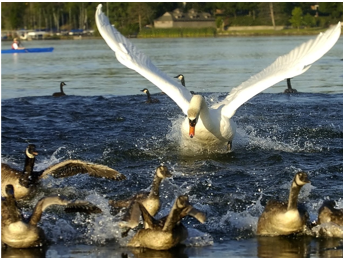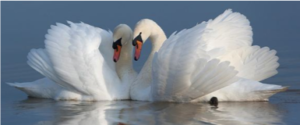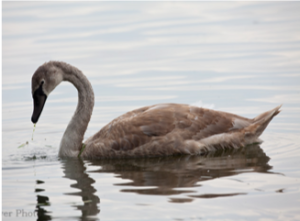
- Appearance: heavy bodies, short black legs, long S-shaped neck, flat orange beak with bulging black knob at base, white plumage
- No difference in coloration between sexes, but male is larger
- During breeding black knobs on males’ bills swell while females’ do not, but this difference is seasonal
- No difference in coloration between sexes, but male is larger
- Height: 50 to 68 inches (about 4 to 5 feet)
- Wingspan: 82 to 94 inches(about 7 to 8 feet)
- Status: common, invasive to New England
- Populations increasing, but common threats include pollution of waterways, fishing line tangles, and occasional shooting by hunters
- Habitat
- Native to Europe and Asia – introduced as domestic, decorative waterfowl in recreational areas and estates during mid-1800s to early 1900s, released birds form population on east coast of United States
- Lakes, ponds, estuaries, bogs, slow-moving rivers and creeks
- Can also be found in areas near a water source where humans frequent, such as parks and gardens
- Diet
- Mainly aquatic vegetation: pondweeds, eelgrass, algae, seaweed
- On land forage for flowering grass, agricultural grains, human handouts
- Paddle with feet on surface of water and skim for algae and tall plants
- Reach under water with long necks, tear up plants with thick, strong beak
- Can submerge up to feet and tails when foraging
- Rake bottom of shallow water to uproot plants
- Sometimes hold wings slightly raised to “sail” with wind to save energy

- Eat up to 8 pounds a day
- Also eat frogs, tadpoles, fish, snails, mollusks, insects
- Mute swans displace native species from breeding and foraging sites, and can damage feeding habitat by overgrazing aquatic vegetation due to voracious appetites
- Mainly aquatic vegetation: pondweeds, eelgrass, algae, seaweed
- Migration
- In native range, mute swans may migrate from Europe to Middle East during cold winter months
- North American populations do not migrate
- Average flight speed is 20-35 mph, top speed is about 50 mph
- Nesting
- Breed on small peninsulas, heavily vegetated shorelines, small to medium islands
- Able to communicate with sounds, but are quieter than other swans
- One mate per breeding season, typically mate for life
- Male mute swans select multiple nest sites by building platform of vegetation
- Females choose best site and pile nest materials (twigs, grasses, leaves, pebbles, etc.) that males bring to them on top of platform
- Mates return to same breeding site each year, often build upon same nest
- Often used to represent romance BUT
- Highly aggressive, attacks other swans, land and shore birds, mammals, and even people when
 approached
approached
- Use hisses, barks, and rattling snorts when threatened
- If vocalization doesn’t work, they snap or charge at intruders
- Average brood is 2-5 eggs – change from blue-green when laid to white, may also be stained green and brown from materials on parents’ feet

- “Young of the Year”
- Learn to walk and swim within day of hatching
- Juveniles have whining calls to attract attention
- First coat of flight feathers are gray
- Fledglings learn to fly after about 65 days, but may stay with parents for 100-150 days after hatching
- As they mature, mute swans become white
- Average lifespan is 10-15 years
- Oldest wild mute swan was about 20, oldest in captivity reached a






